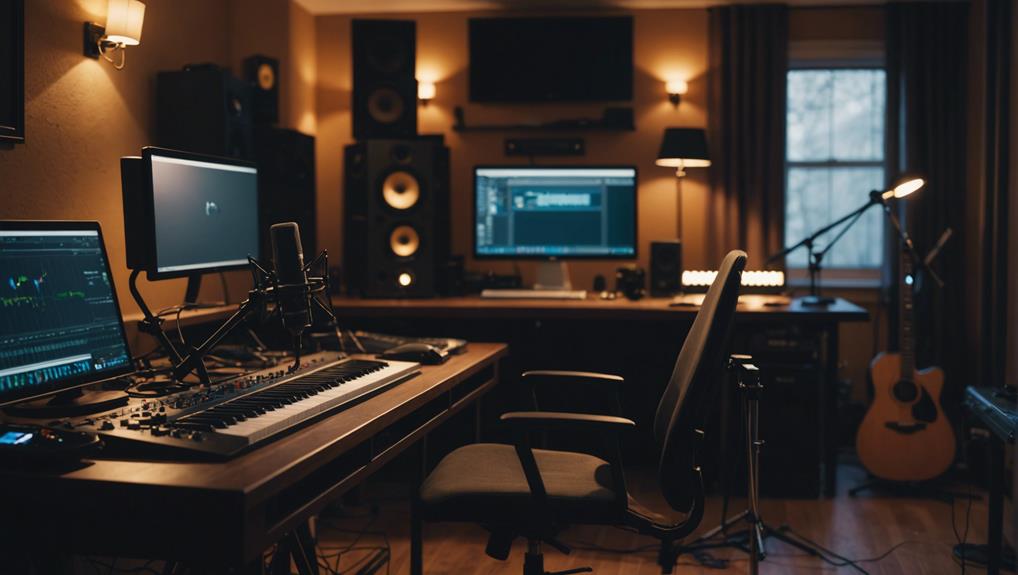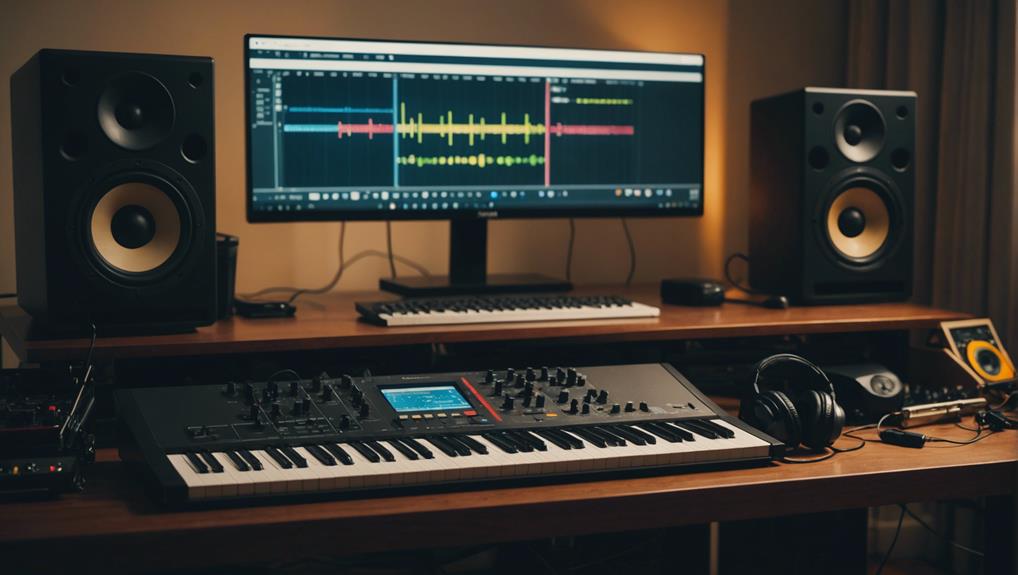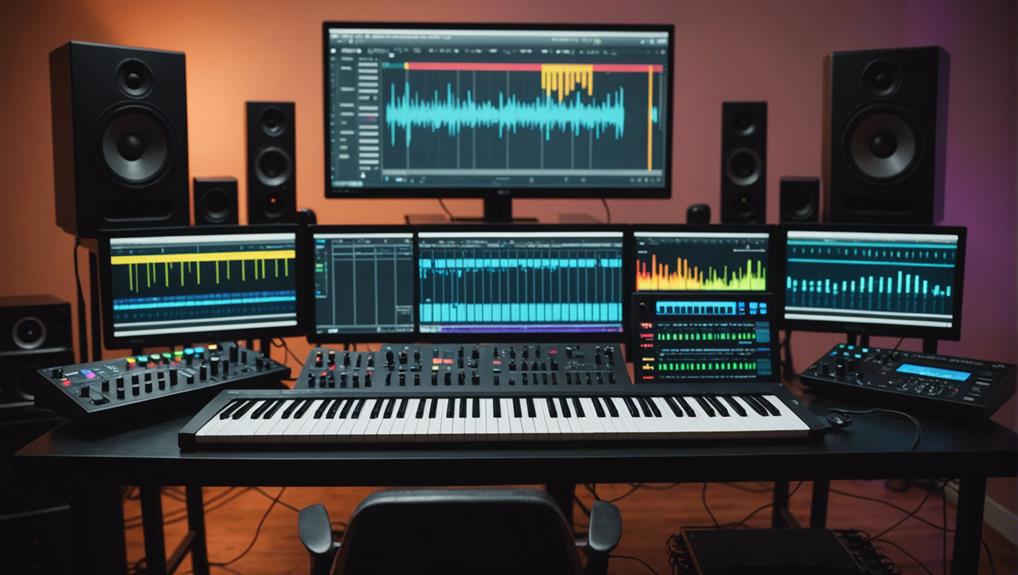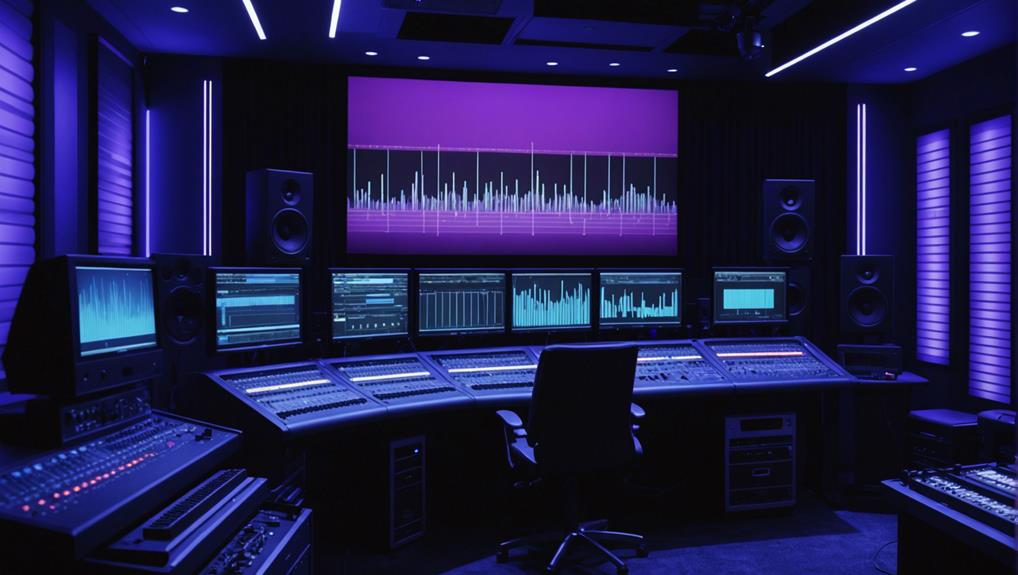Setting up a home studio begins with choosing the right space, one that’s quiet and offers good acoustics. You’ll need to invest in a powerful computer, preferably with at least 8GB of RAM, and select a Digital Audio Workstation (DAW) that aligns with your needs. An audio interface with quality preamps is essential, as are studio monitors with a flat frequency response. But before you get too deep into equipment, think about how you’ll handle acoustic treatment and cable management. Have you considered the impact of proper lighting on your workflow and comfort?
TL-DR
- Choose a quiet room with good acoustics and minimal noise interference.
- Invest in a powerful computer and a compatible Digital Audio Workstation (DAW).
- Select a quality audio interface with multiple inputs/outputs and low-latency monitoring.
- Use studio monitors with a flat frequency response and adjustable EQ settings.
- Install acoustic treatment like panels and bass traps for accurate sound.
Choose the Right Space
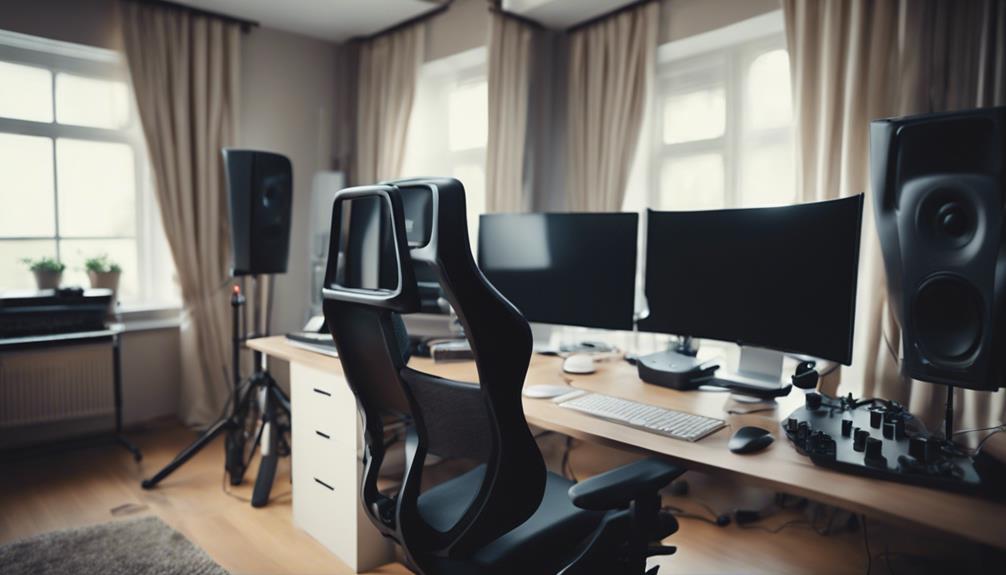
Selecting the appropriate space for your home studio is essential for achieving high-quality recordings and a productive work environment. Start by considering the size and layout of the room. You’ll need enough space to accommodate your recording equipment while providing a comfortable environment for long hours of work.
Ideally, choose a room away from noisy areas like busy streets or common household distractions, ensuring minimal noise interference.
Pay close attention to the acoustics of the room. A space with minimal echo and reverberation will help you achieve cleaner recordings. Rooms with carpets, curtains, and furnishings can help absorb sound, but you might need to add acoustic panels for better results.
Evaluating the potential for soundproofing is also vital. This minimizes external noise and disturbances during your recording sessions, allowing you to capture the best sound possible.
Additionally, make sure the room has adequate lighting and ventilation. Good lighting will help reduce eye strain, while proper ventilation keeps the space comfortable, making it easier to focus on your music production.
Invest in a Computer
Investing in a powerful computer is essential for handling the demands of digital music recording and production. A computer is the heart of your home recording studio equipment, so you’ll need one with a modern processor and at least 8GB of RAM. This guarantees your system can run multiple music production software programs smoothly without lagging. Compatibility with various audio software is vital, so consider this when selecting your machine.
Modern computers not only allow for high-quality digital recordings but also provide efficient workflows, making the music production process more seamless.
Storage is another critical factor. Large music projects can quickly fill up a computer’s internal hard drive, potentially slowing it down. To avoid this, invest in external hard drives for additional storage. This way, you can keep your computer running efficiently while managing extensive audio files.
When setting up your home studio, don’t skimp on your computer. Its processing power and storage capacity will directly impact your ability to produce high-quality music. Make sure your computer meets the demands of your chosen music production software and can handle the complexity of your audio projects without breaking a sweat.
Select a DAW
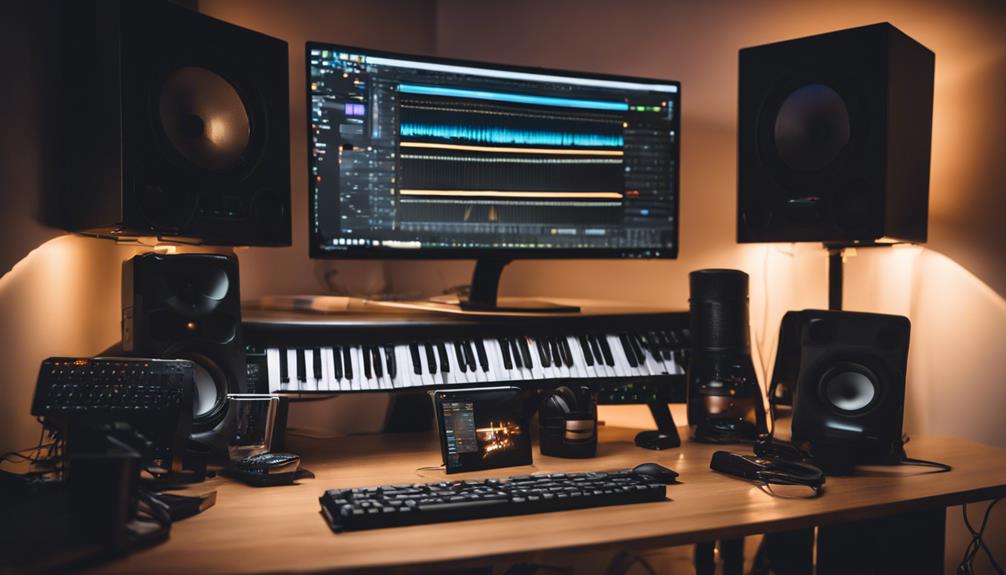
Now that you’ve got your computer, it’s time to choose a Digital Audio Workstation (DAW).
Look at popular options like Pro Tools, Logic Pro, Ableton Live, and FL Studio, each with unique features and system requirements.
Compare their user interfaces to find the one that fits your workflow best.
Popular DAW Options
When choosing a DAW for your home studio, consider how each option aligns with your specific needs and workflow. There are several popular DAWs, each offering unique features that cater to different types of music production.
- Pro Tools: This is a widely used DAW in professional studios, known for its advanced editing and mixing capabilities. If you’re looking for industry-standard software with powerful tools, Pro Tools might be the right choice for you.
- Logic Pro: Popular among Mac users, this DAW boasts a user-friendly interface and an extensive library of virtual instruments. It’s ideal for those who want a comprehensive production suite with a seamless user experience.
- Ableton Live: Favored by electronic music producers, Ableton Live stands out for its powerful performance features and live performance capabilities. If you plan to perform your music live or need a DAW that excels in electronic music production, this is a solid option.
- FL Studio: Renowned for its intuitive workflow, extensive plugin support, and affordability, FL Studio is perfect for beginners. Its straightforward interface makes it easy to start producing music right away.
- Studio One: This DAW is known for its ease of use, flexible workflow, and seamless integration with PreSonus hardware. It’s a great choice if you’re looking for a DAW that offers versatility and a smooth integration with your recording equipment.
Each DAW has its strengths, so choose one that complements your music production style and needs.
System Requirements Overview
Before selecting a DAW, make certain your computer meets at least the minimum system requirements to guarantee smooth performance and reliability. Most DAWs require a computer with at least 8GB of RAM and a modern processor. This ensures that your system can handle the demands of music production without lagging or crashing.
Next, verify the operating system compatibility of the DAW you’re considering. Some DAWs are exclusive to either Windows or macOS, while others may support Linux. Ensuring your chosen DAW is compatible with your operating system will save you a lot of headaches down the road.
Storage space is another critical factor. Music production involves large files, numerous plugins, and extensive project files. A minimum of 1TB of storage is recommended to accommodate everything without running out of space.
User Interface Comparison
After ensuring your system meets the necessary requirements, it’s important to evaluate how the user interface of various DAWs can impact your workflow and productivity. Different DAWs offer unique features that cater to specific needs and preferences, especially for electronic music producers.
Ableton Live is an excellent choice if you prioritize real-time editing and performance capabilities. Its interface is designed for live performances, making it ideal for electronic music producers who need to manipulate sounds on the fly.
Logic Pro stands out with its intuitive interface and extensive library of virtual instruments and effects. This DAW provides a seamless experience for both novices and seasoned producers looking for a versatile toolkit.
Pro Tools is the industry standard in professional studios, known for its advanced audio editing and mixing features. It’s perfect if you need precision and high-quality audio editing capabilities.
FL Studio offers a pattern-based workflow that many hip-hop and electronic music producers find appealing. Its interface is streamlined for creating beats and loops efficiently.
Studio One is renowned for its user-friendly interface and powerful audio recording and editing tools, making it a versatile option for all kinds of music production.
Get an Audio Interface
When selecting an audio interface, prioritize quality to guarantee crisp and clear recordings.
You’ll need to install the necessary drivers for your interface to function properly with your computer.
Look for interfaces that match your connectivity needs and offer features like preamps and low-latency monitoring.
Choose Quality Interfaces
To achieve high-quality recordings, you need an audio interface that connects your microphones and instruments to your computer. This device is essential for transforming analog signals into digital ones, guaranteeing your recordings maintain high fidelity.
When choosing an audio interface for your home studio, consider several factors to optimize your setup.
First, assess the inputs and outputs available. More inputs and outputs allow you to connect multiple microphones and instruments simultaneously, catering to complex recording sessions.
Pay attention to the sample rate as well. Higher sample rates provide better audio quality, which is vital for professional-grade recordings.
Next, evaluate the preamps in the audio interface. High-quality preamps enhance the sound of your microphones, providing a cleaner and more accurate representation of your recordings.
Also, ensure that the interface fits well within your existing home studio acoustics, contributing to an overall balanced and clear sound.
Popular brands like Focusrite, PreSonus, Universal Audio, and Apogee offer a variety of options to suit different budgets and requirements. Here are some key points to remember:
- Multiple inputs and outputs for various recording needs
- High sample rates for better audio quality
- Quality preamps for cleaner sound
- Compatibility with home studio acoustics
- Trusted brands for reliability and performance
Install Necessary Drivers
You’ll need to install the necessary drivers to make sure your audio interface works seamlessly with your computer. An audio interface is vital for connecting microphones and instruments to your system, enabling you to produce high-quality recordings. Drivers are fundamentally software that allows your computer to recognize and communicate with the audio interface effectively.
First, visit the manufacturer’s website to find the latest drivers that are compatible with your operating system. Manufacturers often update drivers to fix bugs and improve performance, so it’s important to get the most recent version. Once on the website, navigate to the support or downloads section, where you can usually find the drivers needed for your specific model of audio interface.
After downloading the drivers, follow the installation instructions carefully. Proper installation is key to ensuring that your audio interface communicates seamlessly with your recording software. This step will help avoid any connectivity issues that could disrupt your recording sessions.
Once installed, restart your computer to finalize the setup. Open your recording software and check if the audio interface is recognized. If everything is set up correctly, you’re ready to start recording with high-quality sound.
Buy Studio Monitors
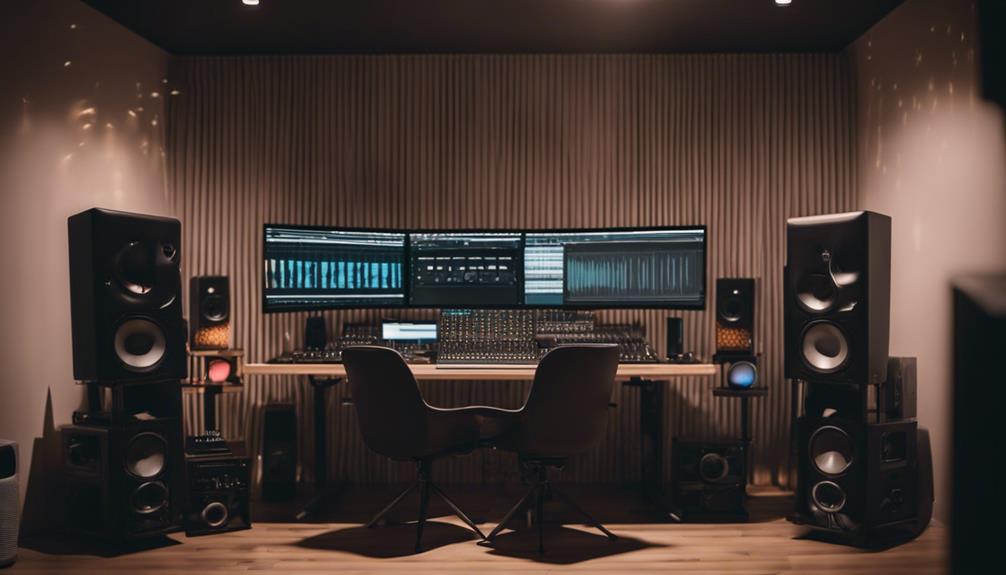
Investing in quality studio monitors is essential for achieving accurate sound reproduction in your home studio. Unlike regular speakers, studio monitors are designed to offer a flat frequency response, guaranteeing you hear your recordings without any coloration. This is vital for making precise adjustments during mixing and mastering.
When selecting studio monitors, consider the size of your room. Larger rooms may benefit from bigger monitors, while smaller spaces might require compact models. Additionally, think about your room’s acoustic treatment. Untreated rooms can skew sound perception, so pairing your monitors with proper acoustic treatment will improve accuracy.
Look for studio monitors with adjustable EQ settings. This feature allows you to customize the sound to your room’s acoustics, ensuring a more accurate playback. Multiple input options can also add flexibility, letting you connect different audio sources seamlessly.
Here are some key points to keep in mind:
- Flat frequency response: Ensures unbiased audio playback.
- Room size: Choose monitors that fit your space.
- Acoustic treatment: Enhances sound accuracy.
- Adjustable EQ settings: Customize sound for your environment.
- Multiple input options: Increases connectivity flexibility.
Purchase a Microphone
Now that you’ve got your studio monitors sorted, it’s time to choose the right microphone for your recording needs. The type of microphone you select can greatly impact your sound quality. Start by considering what you’ll be recording most often.
Dynamic microphones are a great choice for versatility and durability. They handle high sound pressure levels well, making them ideal for recording vocals and instruments in less soundproofed spaces.
If you need something more sensitive and detailed, a condenser microphone might be your best bet. Condenser microphones excel at capturing the nuances of vocals and acoustic instruments, providing a higher level of clarity and detail.
For those seeking a unique, warm, and vintage sound, ribbon microphones are exceptional. They’re often used for recording instruments like guitar amps and brass instruments due to their smooth frequency response.
Once you’ve selected your microphone, connect it to your audio interface. Make sure that it’s properly positioned and that the levels are set correctly for the best sound quality.
Whether you’re capturing the raw energy of a live performance or the delicate intricacies of a vocal track, the right microphone can make all the difference in your home studio setup.
Set Up Headphones
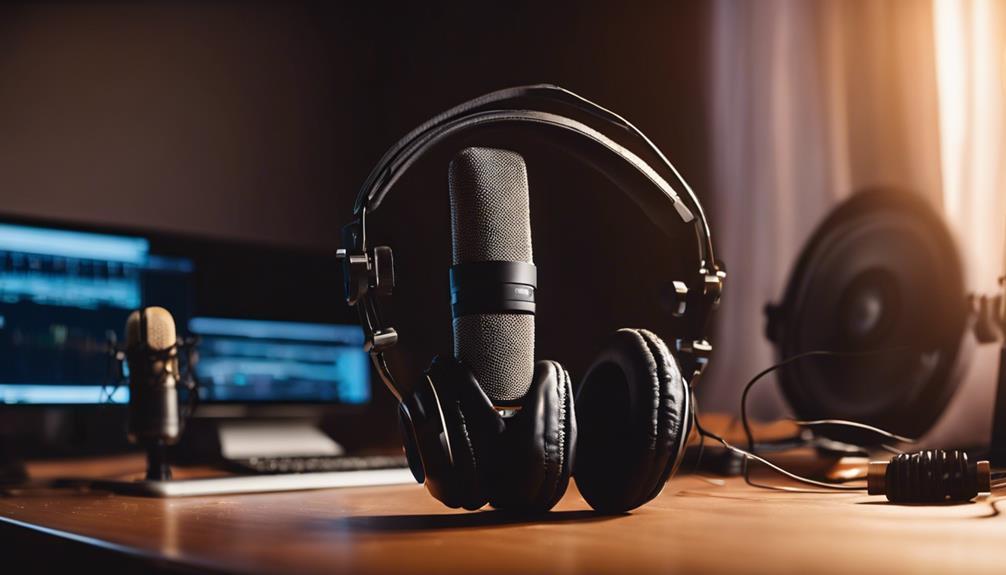
When setting up your home studio, start by choosing quality closed-back headphones for accurate sound reproduction and isolation. Make sure they’ve a wide frequency response and a comfortable over-ear design for long sessions.
Once you have the right headphones, optimize their placement for the best listening experience.
Choose Quality Headphones
For the best sound quality in your home studio, choose studio headphones designed for accuracy rather than consumer models. Studio headphones are essential for critical listening, monitoring, and making sure you achieve an accurate sound.
When selecting headphones to mix and monitor audio, you have two main types to take into account: closed-back and open-back headphones.
Closed-back headphones provide excellent isolation, making them ideal for tracking and recording sessions where you don’t want external noise to interfere. On the other hand, open-back headphones offer a more natural sound, making them perfect for mixing and mastering, where precise sound reproduction is essential.
To guarantee comfort during long recording sessions, opt for headphones with comfortable ear cups. Additionally, a wide frequency response is essential for capturing all the nuances in your audio. Durability is also key, so look for headphones with a long, sturdy cable and robust construction.
Here are key features to look for:
- Closed-back headphones for isolation during recording.
- Open-back headphones for accurate mixing and mastering.
- Wide frequency response to capture detailed audio.
- Comfortable ear cups for extended use.
- Durable build with a long, sturdy cable.
Choosing the right headphones will have a significant impact on your home studio’s sound quality and overall recording experience.
Optimize Headphone Placement
After selecting the right headphones, it’s important to position them correctly for best sound quality and comfort. Start by creating a triangle with your ears and the speakers for optimal sound. This means your headphones should align with the angle formed by your ears and the speakers. This setup ensures that you receive a well-balanced audio experience.
Next, adjust the headband to fit snugly, but not too tight. You don’t want excessive pressure on your head, as this can lead to discomfort during long sessions. Make sure the ear cushions create a comfortable seal around your ears. This seal helps with sound isolation, which is essential for accurate monitoring.
For tracking, use closed-back headphones to minimize sound leakage and keep external noise out. When mixing and referencing, opt for open-back headphones to get a more natural soundstage and better spatial awareness.
Additionally, consider the impedance and sensitivity of your headphones. Make sure they match well with your audio interface to achieve excellent performance. Proper impedance matching ensures you get the best sound quality without overloading your equipment.
Install Acoustic Treatment
Installing acoustic treatment is vital to achieving professional sound quality in your home studio. By controlling sound reflections and reverberations, you can guarantee accurate monitoring and recording.
Start with acoustic panels to reduce echoes and improve sound clarity. Place these panels on walls where sound reflections are most likely, such as directly opposite your speakers.
Bass traps are another essential component. They absorb low-frequency sound waves, preventing the boomy or muddy sounds that can ruin your recordings. Position bass traps in the corners of your room, where low-frequency buildup is most common.
Diffusers help scatter sound reflections, creating a balanced and natural acoustic environment. Unlike acoustic panels, which absorb sound, diffusers spread it out, reducing the risk of overly dead or flat-sounding recordings. Place diffusers on the rear wall or ceiling to effectively manage sound reflections.
Here’s a quick checklist to guide your acoustic treatment setup:
- Acoustic Panels: Place on walls to reduce echoes.
- Bass Traps: Position in corners to absorb low-frequency sounds.
- Diffusers: Install on rear walls or ceilings to scatter reflections.
- First Reflection Points: Treat these areas on side walls.
- Ceiling Clouds: Hang above your mixing position for additional absorption.
Organize Cables and Stands
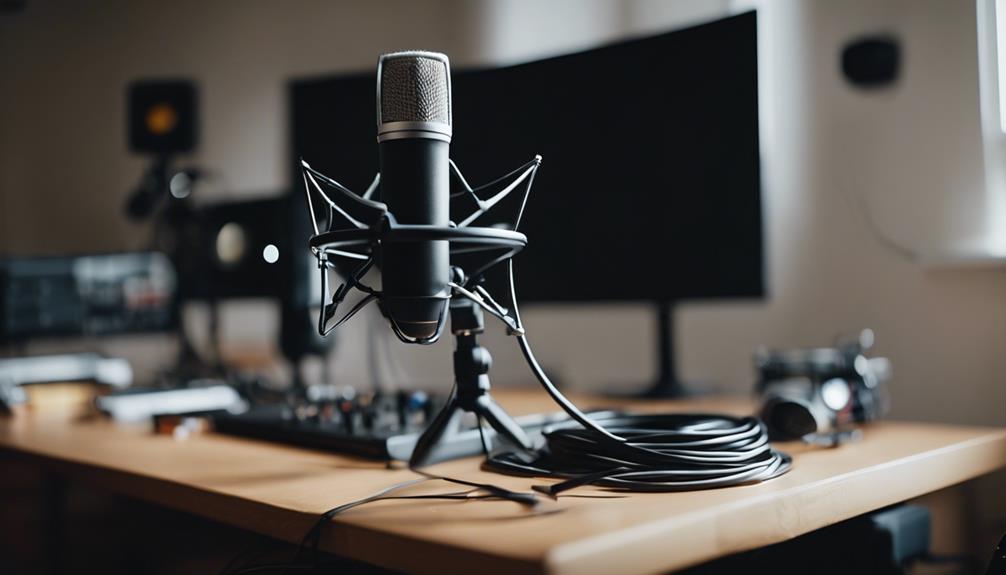
Properly organizing cables and stands is essential to maintain a clean and efficient home studio setup. Start by using cable management tools like Velcro straps or cable ties. These will keep your cables from getting tangled and make your space look much tidier.
Next, invest in sturdy microphone stands and adjustable boom arms. These stands will give you versatile positioning options, ensuring you capture the best sound during recording sessions.
Don’t forget to use shock mounts for your microphones. These mounts are vital for reducing vibrations and unwanted noise, which can ruin an otherwise perfect recording.
To keep your cables out of the way, use cable clips or mounts along your walls or desk. This simple step keeps your workspace clutter-free and helps prevent accidental disconnections.
Lastly, make sure to label cables with color-coded tags or labels. Doing so will make it easier to identify and trace connections in your home studio setup, saving you time and frustration when you need to adjust or troubleshoot.
Add a MIDI Keyboard
Now that your cables and stands are organized, it’s time to enhance your setup with a MIDI keyboard. A MIDI keyboard is essential for playing virtual instruments and improving your music production workflow. It allows you to sample, create drum loops, and add melodies to your tracks effortlessly.
Connecting a MIDI keyboard to your computer via USB is straightforward and integrates smoothly with your music software. This connection guarantees that you can control various virtual instruments directly from the keyboard, making your creative process more intuitive.
When choosing a MIDI keyboard, consider your music production needs. MIDI keyboards come in different sizes and layouts, so pick one that complements your style.
Here are some key points to think about:
- Portability: If you need to move your setup frequently, a smaller, more portable MIDI keyboard might be ideal.
- Key Count: Depending on your music production style, you might prefer a keyboard with more keys for a broader range.
- Compatibility: Make sure the keyboard works seamlessly with your preferred music software.
- Additional Controls: Look for extra features like drum pads, faders, and knobs to enhance your workflow.
- Build Quality: A durable keyboard can withstand long hours of production.
Create a Comfortable Workspace
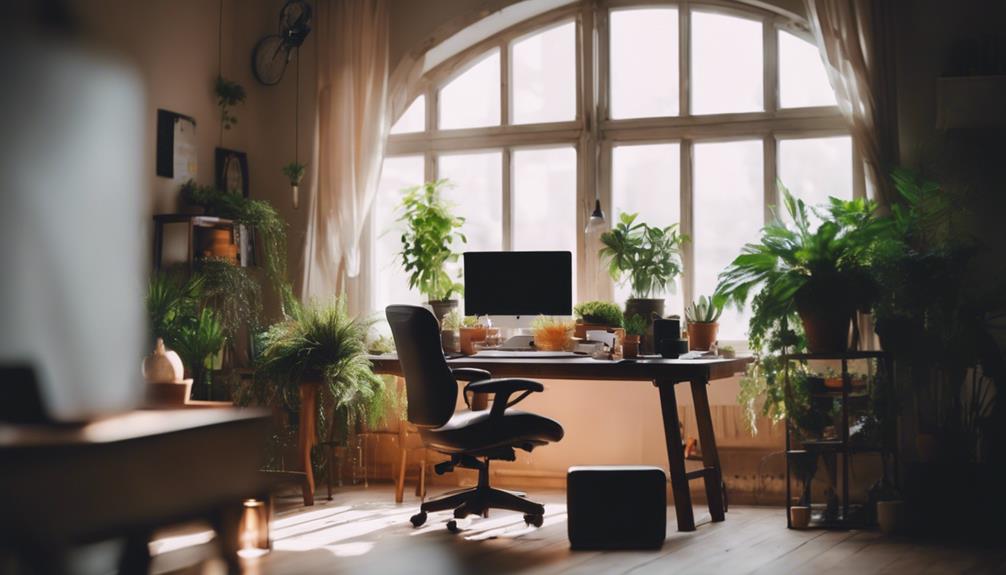
Establishing a comfortable workspace is essential for optimizing your productivity and creativity in your home studio. Start by choosing a desk and chair that promote both comfort and creativity. You’ll be spending a lot of time here, so ergonomic design is essential. A quiet location is key for minimizing noise disturbances, ensuring you can focus on your music production without distractions.
Next, consider acoustically treating your space. Soundproofing elements like foam panels can help create an ideal recording environment. This step is especially important if you’re using MIDI Keyboards or other audio equipment that requires precise sound capture.
Lighting also plays a significant role in setting the mood. Opt for adjustable lighting options to suit different times of the day and various tasks.
Efficient cable management is another crucial aspect. Tidy up your workspace using cable ties and storage solutions to avoid a tangled mess of wires, which can be both distracting and hazardous.
Lastly, ensure that all your essential equipment is within easy reach. A well-organized space allows you to concentrate on creating music, not searching for cables or adjusting your setup constantly.
A thoughtfully designed workspace will boost your productivity and creativity in your home studio.
Next up, learn how to setup your studio monitors in this guide.
